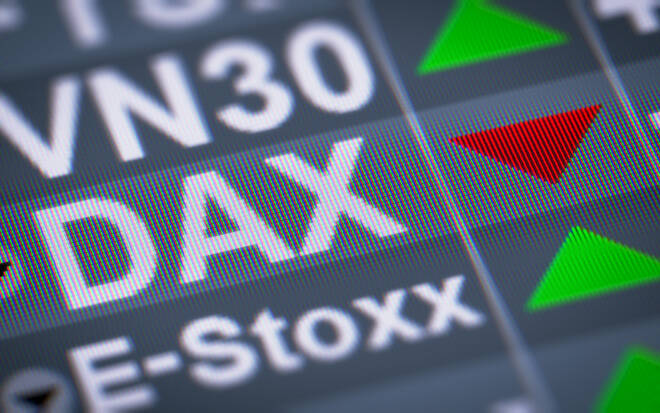Advertisement
Advertisement
European Equities: Manufacturing PMIs and German Retail Sales in Focus
By:
It's a busy day ahead on the economic calendar, with manufacturing PMI and retail sales figures in focus. COVID-19 news updates will also influence, however.
Italy IHS Markit Manufacturing PMI JUL
French Markit Manufacturing PMI Final JUL
German Markit Manufacturing PMI Final JUL
Eurozone Markit Manufacturing PMI Final JUL
Tuesday, 3rd August
Spain Unemployment Change JUL
Wednesday, 4th August
Spain Markit Services PMI JUL
Italy IHS Markit Services PMI JUL
French Markit Services PMI Final JUL
German Markit Services PMI Final JUL
Eurozone Markit Services PMI Final JUL
Eurozone Retail Sales MoM JUN
Thursday, 5th August
German Factory Orders MoM JUN
German Construction PMI JUL
ECB Economic Bulletin
Friday, 6th August
German Industrial Production MoM JUN
The Majors
It was a bearish end to a bullish month of July for the European majors on Friday,
The CAC40 fell by 0.32%, with the DAX30 and the EuroStoxx600 ending the day down by 0.61% and by 0.45% respectively.
Disappointing GDP numbers from Germany followed weaker than expected 2nd quarter GDP numbers from the U.S on Thursday.
Adding to the market angst at the end of the week was further concern over the continued spread of the Delta variant.
From China, the CSI300 and the Hang Seng resumed their downward trajectories amid regulatory uncertainty placing further pressure on riskier assets at the end of the month. Beijing’s attempts to calm the markets failed late in the week, with the Hang Seng and CSI300 ending the week down by 4.98% and by 5.46% respectively.
Limiting the damage, however, was better than expected 2nd quarter GDP numbers for France and the Eurozone.
The Stats
Following interest in the German economy through much of the week, it was the Eurozone and member state economies in focus on Friday.
The numbers were skewed to the positive, supporting market optimism.
Member States
In the 2nd quarter, the French economy expanded by 0.9%, quarter-on-quarter, reversing a 0.1% contraction in the previous quarter.
The German economy expanded by 1.5%, partially reversing a 2.1% contraction from the 1st quarter.
Italy and Spain also saw growth in the quarter.
In the 2nd quarter, the Spanish economy grew by 2.8%, reversing a 0.4% contraction from the 1st quarter. Stats from Italy were also positive, with the economy growing by 2.7%. In the 1st quarter, the economy had grown by just 0.2%, quarter-on-quarter.
The Eurozone
In the 2nd quarter, the Eurozone economy grew by 2.0%, quarter-on-quarter, reversing a 0.3% contraction from the previous quarter.
Year-on-year, the economy grew by 13.7% after having contracted by 1.3% in the previous quarter. Economists had forecast a 12.6% increase.
Inflation figures were also in focus, with the annual rate of inflation ticking up from 1.9% to 2.2%. Economists had forecast an annual rate of inflation of 2.0%.
The pickup in inflationary pressures muted unemployment figures for the Eurozone, however. In June, the Eurozone’s unemployment rate slipped from 8.0% to 7.7%. Economists had forecast a fall to 7.8%.
From the U.S
Personal spending and inflation were in focus later in the European session.
The stats were skewed to the positive for riskier assets but failed to give the European majors a boost.
Personal spending rose by 1.0% in June, coming in well ahead of a forecasted 0.5% increase.
Inflationary pressures picked up less than expected, with the annual rate of inflation picking up from 3.4 to 3.5%. Economists had forecast 3.6% for June.
The Market Movers
For the DAX: It was a bearish day for the auto sector on Friday. Daimler and BMW both saw losses of 1.17% respectively to lead the way down. Continental and Volkswagen ended the day down by 0.99% and by 0.46% respectively.
It was also a bearish day for the banks. Deutsche Bank and Commerzbank fell by 1.57% and by 0.18% respectively.
From the CAC, it was a bearish day for the banks. BNP Paribas fell by 1.19%, with Soc Gen and Credit Agricole declining by 1.01% and by 0.86% respectively.
It wasn’t much better for the French auto sector. Stellantis NV fell by 1.00%, with Renault ending the day down by 3.35%.
Air France-KLM slid by 4.58%, with Airbus SE falling by 0.26%
On the VIX Index
It was back into the green for the VIX on Friday, marking the 3rd gain of the week.
Reversing a 3.33% fall from Thursday, the VIX rose by 3.05% to end the day at 18.24.
The NASDAQ fell by 0.71%, with the Dow and the S&P500 ending the day down by 0.42% and by 0.54% respectively.
The Day Ahead
It’s a particularly busy day ahead on the economic calendar. Eurozone and member state manufacturing PMI numbers for July will be in focus along with retail sales figures from Germany.
Barring any marked revision to prelim PMIs for France and Germany, expect Italy and the Eurozone’s PMIs to be key. German retail sales figures will also draw plenty of interest, however.
With Germany’s unemployment rate in decline, the markets will be looking for a pickup in spending to support the economic recovery. Weak numbers may test support on the day.
From the U.S, ISM Manufacturing PMI numbers late in the day will also draw attention.
Ahead of the European open, however, China’s Caixin Manufacturing PMI will set the tone. NBS Manufacturing numbers from the weekend were disappointing.
Away from the economic calendar, COVID-19 news updates will also need considering, however.
The Futures
In the futures markets, at the time of writing, the Dow Mini was up by 130 points.
For a look at all of today’s economic events, check out our economic calendar.
About the Author
Bob Masonauthor
With over 28 years of experience in the financial industry, Bob has worked with various global rating agencies and multinational banks. Currently he is covering currencies, commodities, alternative asset classes and global equities, focusing mostly on European and Asian markets.
Advertisement
